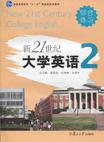新21世纪大学英语综合练习
2010-10
复旦大学出版社
翟象俊,等 编
163
2004年教育部制定的《大学英语课程教学要求》,明确提出“大学英语的教学目标是培养学生的英语综合应用能力,特别是听说能力,使他们在今后工作和社会交往中能用英语有效地进行口头和书面的信息交流。”这一要求无疑是为当今的大学英语教学树立了方向标:着力改变以语法、阅读为核心的英语教学传统,而朝着语言技能全面并举的方向倾斜。新大纲推动了英语教学的变革,而教学的实际需求,更催唤着新一代教材的诞生。《新21世纪大学英语》,正是在这一形势下审慎推出的一套力求体现大学英语编写新理念的系列教材。 上世纪90年代后期我们在编写《21世纪大学英语》时,除了强调选材的内容清新、语言生动外,在练习编写和教学过程中更突出听、说、读、写、译诸方面语言技能的培养。与此同时,也开始利用现代化教育技术手段,如课件光盘及学习软件系统等,积极展开以学生为中心的课堂教学活动。现今推出的《新21世纪大学英语》系列教材,以功能意念贯穿始终,充分利用现代计算机技术、网络技术和多媒体教学手段,全面提高学生的英语视、听、说、读、写、译的实用技能,以“立体化”的方式体现教学活动的实用性以及语言的交际功能。 《新21世纪大学英语》是根据国家教育部颁发的《大学英语课程教学要求》并参照《大学英语四、六级考试大纲》精神而编写的系列教材,包括《综合教程》、《综合练习》、《教师参考书》(各四册)及相关配套网络平台。原《21世纪大学英语》教材,是采用主题教学法则(theme-based)加以编写的,即:单元内A\B课文中形成同一主题,另外再在《综合练习》内也配以一定数量的同类题材练习材料。《新2l世纪大学英语》虽仍沿用这一教学法则,但是进一步把视、听、说、读、写、译各项能力互相交织且有机结合起来,这种针对性强的、符合外语教学规律的综合反复训练,既利于提高学生的综合应用能力,又完整实现了真正意义上的主题教学法。
《新21世纪大学英语2综合练习》以功能意念贯穿始终,充分利用现代计算机技术、网络技术和多媒体教学手段,全面提高学生的英语视、听、说、读、写、译的实用技能,以“立体化”的方式体现教学活动的实用性以及语言的交际功能。
Unit 1 Bonds of FriendshipPart I ListeningPart II Vocabulary and StructurePart III TranslatingPart IV ReadingPart V WritingUnit 2 Road to SuccessPart I ListeningPart II Vocabulary and StructurePart III TranslatingPart IV ReadingPart V WritingUnit 3 Being True to One's SelfPart I ListeningPart II Vocabulary and StructurePart III TranslatingPart IV ReadingPart V WritingUnit 4 Cultural ValuesPart I ListeningPart 11 Vocabulary and StructurePart III TranslatingPart IV ReadingPart V WritingUnit 5 APiece of AdvicePart I ListeningPart II Vocabulary and StructurePart III TranslatingPart IV ReadingPart V WritingUnit 6 Future WorldPart I ListeningPart II Vocabulary and StructurePart III TranslatingPart IV ReadingPart V WritingUnit 7 Non-Human EarthlingsPart I ListeningPart II Vocabulary and StructurePart III TranslatingPart IV ReadingPart V WritingUnit 8 New TechnologyPart I ListeningPart II Vocabulary and StructurePart III TranslatingPart IV ReadingPart V WritingKey
"I was dying inside for him," she said. "There were enough of us on the bus who were feeling awful -- we could have done something. But none of us said anything, " Peggy still can't explain why she didn't stick up for Stewart. She had known those boys since they were all little kids, and she didn't find them threatening. She thinks if she had spoken up on his behalf, other kids might have helped her to make the teasing stop. But perhaps most surprising -- and upsetting -- to Peggy is that she considers herself a moral person, yet those convictions aren't backed up by her conduct on the bus."I think I would say something now, but I don't know for sure," she said. "Maybe if I saw someone being beaten up and killed, I'd just stand there. That still worries me. "Many of us share Peggy's concern. We've all found ourselves in similar situations: the times we've seen someone harassed (骚扰) on the street and didn't intervene (介入) ; when we've driven past a car stranded (抛锚) by the side of the road, assuming another driver would pull over to help; even when we've noticed litter on the sidewalk and left it for someone else to pick up. We see a problem, consider some kind of positive action, then respond by doing.., nothing. Something holds us back. We remain bystanders. Why don't we help in these situations? This is a question that haunts all of us. Every day we serve as bystanders to the world around us -- not just to people in need on the street but to larger social, political, and environmental problems that concern us, but which we feel powerless to address on our own. Indeed, the bystander phenomenon pervades the history of the past century. ......
